key MITSUBISHI ECLIPSE CROSS 2018 Owner's Manual (in English)
[x] Cancel search | Manufacturer: MITSUBISHI, Model Year: 2018, Model line: ECLIPSE CROSS, Model: MITSUBISHI ECLIPSE CROSS 2018Pages: 417, PDF Size: 74.06 MB
Page 10 of 417
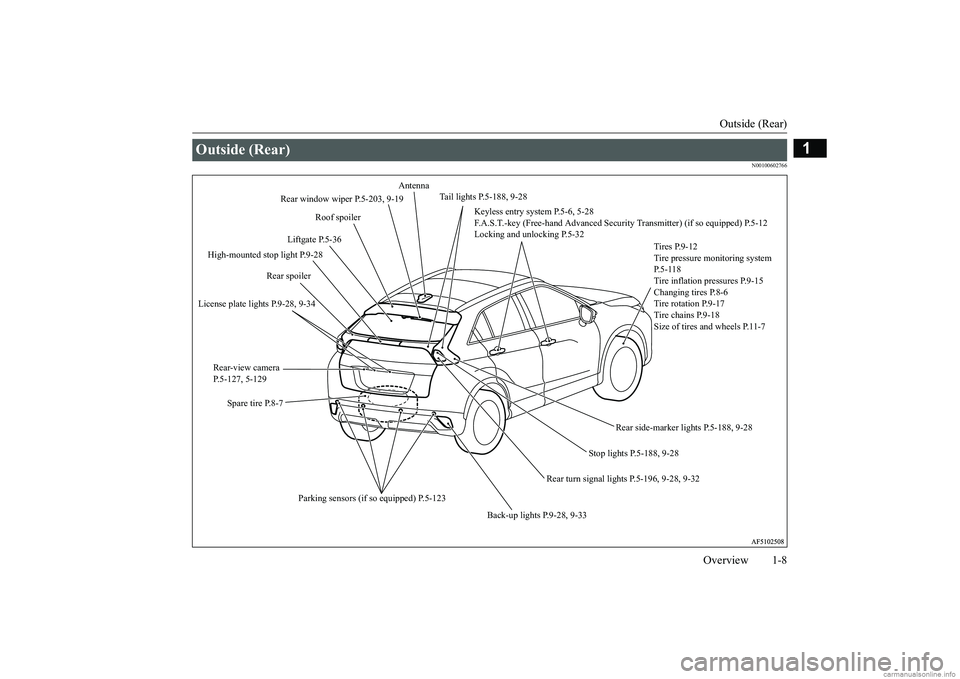
Outside (Rear)
Overview 1-8
1
N00100602766
Outside (Rear)
Keyless entry system P.5-6, 5-28 F.A.S.T.-key (Free-hand Advanced Securi
ty Transmitter) (if so equipped) P.5-12
Locking and unlocking P.5-32
Tires P.9-12 Tire pressure monitoring system P.5-118Tire inflation pressures P.9-15 Changing tires P.8-6 Tire rotation P.9-17Tire chains P.9-18 Size of tires and wheels P.11-7
Stop lights P.5-188, 9-28
Rear turn signal lights P.5-196, 9-28, 9-32
Spare tire P.8-7
License plate lights P.9-28, 9-34
Rear-view camera P.5-127, 5-129
Rear window wiper P.5-203, 9-19
High-mounted stop light P.9-28
Antenna
Liftgate P.5-36
Rear side-marker lights P.5-188, 9-28
Tail lights P.5-188, 9-28
Back-up lights P.9-28, 9-33
Roof spoiler
Rear spoiler
Parking sensors (if so equipped) P.5-123
BK0252700US.bo
ok 8 ページ 2017年10月4日 水曜日 午後4時54分
Page 15 of 417
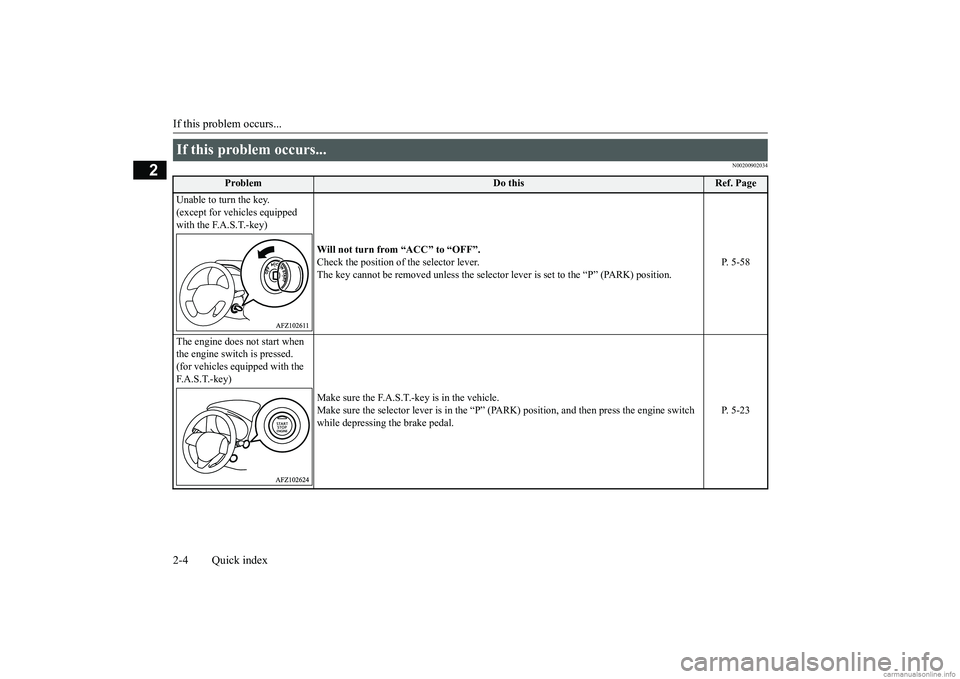
If this problem occurs... 2-4 Quick index
2
N00200902034
If this problem occurs...
Problem
Do this
Ref. Page
Unable to turn the key. (except for vehicles equipped with the F.A.S.T.-key)
Will not turn from “ACC” to “OFF”. Check the position of the selector lever. The key cannot be removed unless the selector
lever is set to the “P” (PARK) position.
P. 5-58
The engine does not start when the engine switch is pressed.(for vehicles equipped with the F. A . S . T. - k e y )
Make sure the F.A.S.T.-key is in the vehicle. Make sure the selector lever is in the “P” (PAR
K) position, and then press the engine switch
while depressing the brake pedal.
P. 5-23
BK0252700US.bo
ok 4 ページ 2017年10月4日 水曜日 午後4時54分
Page 16 of 417
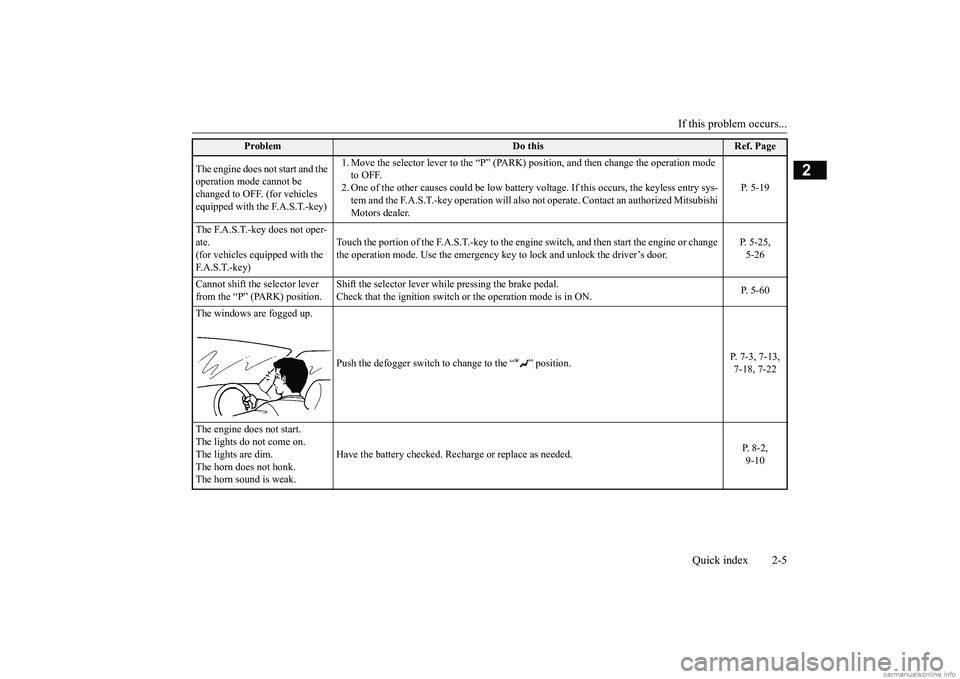
If this problem occurs...
Quick index 2-5
2
The engine does not start and the operation mode cannot be changed to OFF. (for vehicles equipped with the F.A.S.T.-key)
1. Move the selector lever to the “P” (PARK)
position, and then change the operation mode
to OFF. 2. One of the other causes could be low battery
voltage. If this occurs, the keyless entry sys-
tem and the F.A.S.T.-key operation will also no
t operate. Contact an authorized Mitsubishi
Motors dealer.
P. 5-19
The F.A.S.T.-key does not oper- ate.(for vehicles equipped with the F. A . S . T. - k e y )
Touch the portion of the F.A.S.T.-key to the engine
switch, and then start the engine or change
the operation mode. Use the emergency key to lock and unlock the driver’s door.
P. 5-25, 5-26
Cannot shift the selector lever from the “P” (PARK) position.
Shift the selector lever while pressing the brake pedal. Check that the ignition switch or the operation mode is in ON.
P. 5-60
The windows are fogged up.
Push the defogger switch to
change to the “ ” position.
P. 7-3, 7-13, 7-18, 7-22
The engine does not start. The lights do not come on. The lights are dim.The horn does not honk. The horn sound is weak.
Have the battery checked. Recharge or replace as needed.
P. 8-2, 9-10
Problem
Do this
Ref. Page
BK0252700US.bo
ok 5 ページ 2017年10月4日 水曜日 午後4時54分
Page 29 of 417
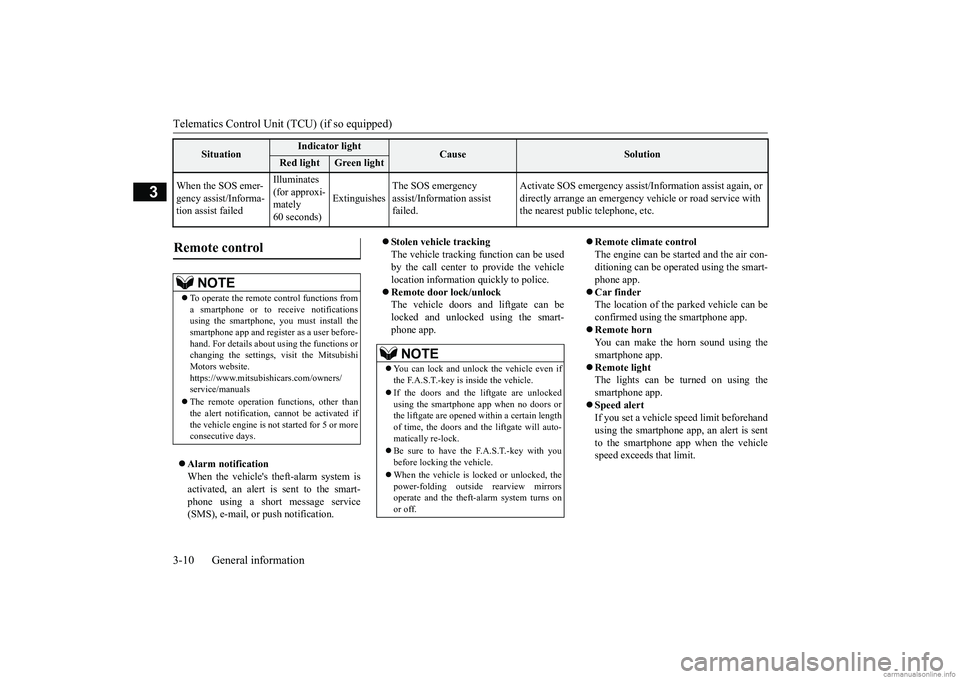
Telematics Control Unit (TCU) (if so equipped) 3-10 General information
3
Alarm notification When the vehicle's theft-alarm system is activated, an alert is sent to the smart- phone using a short message service(SMS), e-mail, or push notification.
Stolen vehicle tracking The vehicle tracking function can be usedby the call center to provide the vehicle location information quickly to police. Remote door lock/unlock The vehicle doors and liftgate can be locked and unlocked using the smart- phone app.
Remote climate control The engine can be started and the air con-ditioning can be operated using the smart- phone app. Car finder The location of the parked vehicle can be confirmed using the smartphone app. Remote horn You can make the horn sound using thesmartphone app. Remote light The lights can be turned on using thesmartphone app. Speed alert If you set a vehicle speed limit beforehandusing the smartphone app, an alert is sent to the smartphone app when the vehicle speed exceeds that limit.
When the SOS emer- gency assist/Informa- tion assist failed
Illuminates (for approxi-mately 60 seconds)
Extinguishes
The SOS emergency assist/Information assist failed.
Activate SOS emergency assist/I
nformation assist again, or
directly arrange an emergency
vehicle or road service with
the nearest public telephone, etc.
Situation
Indicator light
Cause
Solution
Red light
Green light
Remote control
NOTE
To operate the remote control functions from a smartphone or to receive notifications using the smartphone, you must install thesmartphone app and register as a user before- hand. For details about using the functions or changing the settings,
visit the Mitsubishi
Motors website. https://www.mitsubishicars.com/owners/ service/manuals The remote operation functions, other than the alert notification, cannot be activated ifthe vehicle engine is not started for 5 or more consecutive days.
NOTE
You can lock and unlock the vehicle even if the F.A.S.T.-key is inside the vehicle. If the doors and the liftgate are unlocked using the smartphone app when no doors or the liftgate are opened within a certain length of time, the doors and the liftgate will auto-matically re-lock. Be sure to have the F.A.S.T.-key with you before locking the vehicle. When the vehicle is locked or unlocked, the power-folding outside rearview mirrors operate and the theft-alarm system turns on or off.
BK0252700US.bo
ok 10 ページ 2017年10月4日 水曜日 午後4時54分
Page 54 of 417
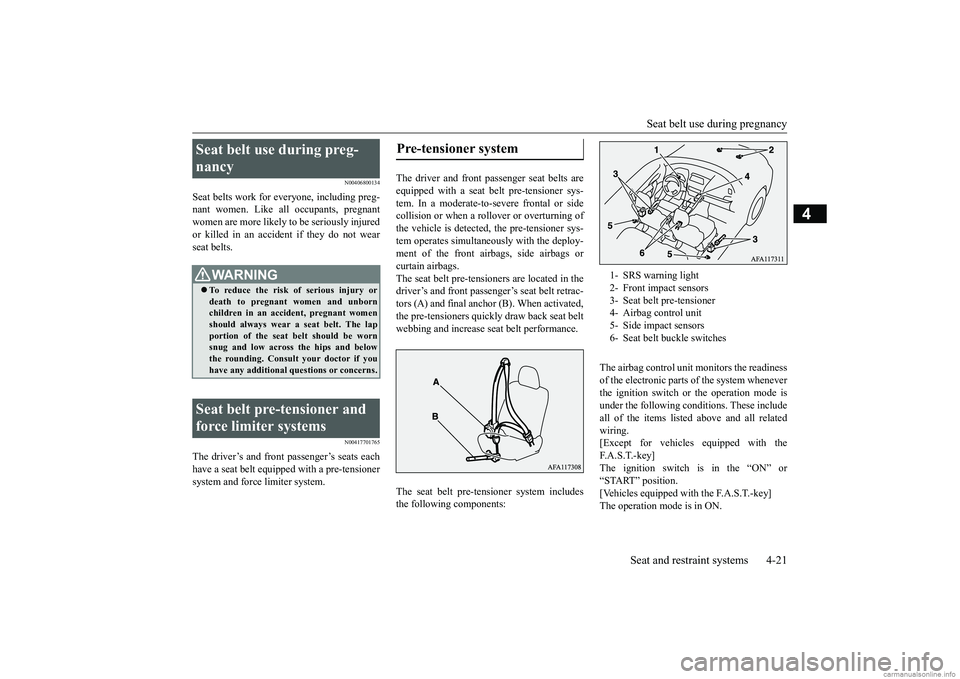
Seat belt use during pregnancy
Seat and restraint systems 4-21
4
N00406800134
Seat belts work for ev
eryone, including preg-
nant women. Like all occupants, pregnantwomen are more likely to be seriously injured or killed in an accident if they do not wear seat belts.
N00417701765
The driver’s and front passenger’s seats eachhave a seat belt equipped with a pre-tensioner system and force limiter system.
The driver and front passenger seat belts are equipped with a seat belt pre-tensioner sys-tem. In a moderate-to-severe frontal or side collision or when a rollover or overturning of the vehicle is detected, the pre-tensioner sys-tem operates simultaneously with the deploy- ment of the front airbags, side airbags or curtain airbags.The seat belt pre-tensioners are located in thedriver’s and front passenger’s seat belt retrac- tors (A) and final anchor (B). When activated, the pre-tensioners quickly draw back seat beltwebbing and increase seat belt performance. The seat belt pre-tensioner system includes the following components:
The airbag control unit monitors the readiness of the electronic parts of the system wheneverthe ignition switch or the operation mode is under the following conditions. These include all of the items listed above and all relatedwiring. [Except for vehicles equipped with the F. A . S . T. - k e y ]The ignition switch is in the “ON” or “START” position. [Vehicles equipped with the F.A.S.T.-key]The operation mode is in ON.
Seat belt use during preg- nancy
WA R N I N G To reduce the risk of serious injury or death to pregnant women and unbornchildren in an accident, pregnant women should always wear a seat belt. The lap portion of the seat belt should be wornsnug and low across the hips and below the rounding. Consult your doctor if you have any additional questions or concerns.
Seat belt pre-tensioner and force limiter systems
Pre-tensioner system
1- SRS warning light 2- Front impact sensors 3- Seat belt pre-tensioner 4- Airbag control unit5- Side impact sensors 6- Seat belt buckle switches
BK0252700US.bo
ok 21 ページ 2017年10月4日 水曜日 午後4時54分
Page 62 of 417
![MITSUBISHI ECLIPSE CROSS 2018 Owners Manual (in English) Child restraint systems
Seat and restraint systems 4-29
4
10. [For front passenger’s seat]
Repeat steps 8 and 9. [For rear seats] Adjust the seatback angle forward untilthe child restraint system MITSUBISHI ECLIPSE CROSS 2018 Owners Manual (in English) Child restraint systems
Seat and restraint systems 4-29
4
10. [For front passenger’s seat]
Repeat steps 8 and 9. [For rear seats] Adjust the seatback angle forward untilthe child restraint system](/img/19/34869/w960_34869-61.png)
Child restraint systems
Seat and restraint systems 4-29
4
10. [For front passenger’s seat]
Repeat steps 8 and 9. [For rear seats] Adjust the seatback angle forward untilthe child restraint system is firmly secured, and then check that the seatback is locked in place. Then push and pull thechild restraint system in all directions to check that it is installed securely. If your child restraint system requires theuse of a tether strap, fasten the tether strapin accordance with the following step 11.
11. Latch the tether strap hook (A) of the
child restraint system to the tether anchorbar (B) and tighten the tether strap so it is securely fastened.
12. Before putting your child in the restraint,
push and pull the restraint in all directionsto be sure it is firmly secure. Do thisbefore each use. If the child restraint sys- tem is not firmly secure, repeat steps 4 through 11.
13. To remove a child restraint system from
the vehicle and deactivate the ALR mode, remove the child from the restraint.Unlatch the buckle. Then remove the belt from the restraint and let the belt fully retract.
14. Reinstall the head restraint.
Refer to “Head restraints” on page 4-9.
N00407601628
Children who have outgrown a child restraint system should be seated in the rear seat andwear the seat belt. If the shoulder belt crosses their face or neck, and/or the lap belt crosses their stomach, a commercially available
booster seat must be used to raise the child so that the shoulder belt crosses their shoulder and the lap belt remains positioned low across their hips. The booster seat should fitthe vehicle seat and have a label certifying compliance with Federal Motor Vehicle Safety Standards or Motor Vehicle RestraintSystems and Booster Seats Safety Regula- tions.
WA R N I N G Child restraint system tether anchors are designed only to withstand loads from cor- rectly fitted child restraint systems. Under no circumstances are they to be used for adult seat belts, harnesses, for attachingother items, or equipment to the vehicle.
Children who have outgrown child restraint systems
WA R N I N G Any child who is too small to properly wear a seat belt must be properly restrained in an appropriate child restraint system, to reduce their risk ofserious injury or death in an accident. A child should never be left unattended in, or unsupervised around, your vehicle. When you leave the vehicle, always take the child out as well. Children can die from he
at stroke if left or
trapped inside the vehicle, especially onhot days. Keep your vehicle locked when not in use. Keep your vehicle keys away from chil- dren.
BK0252700US.bo
ok 29 ページ 2017年10月4日 水曜日 午後4時54分
Page 66 of 417
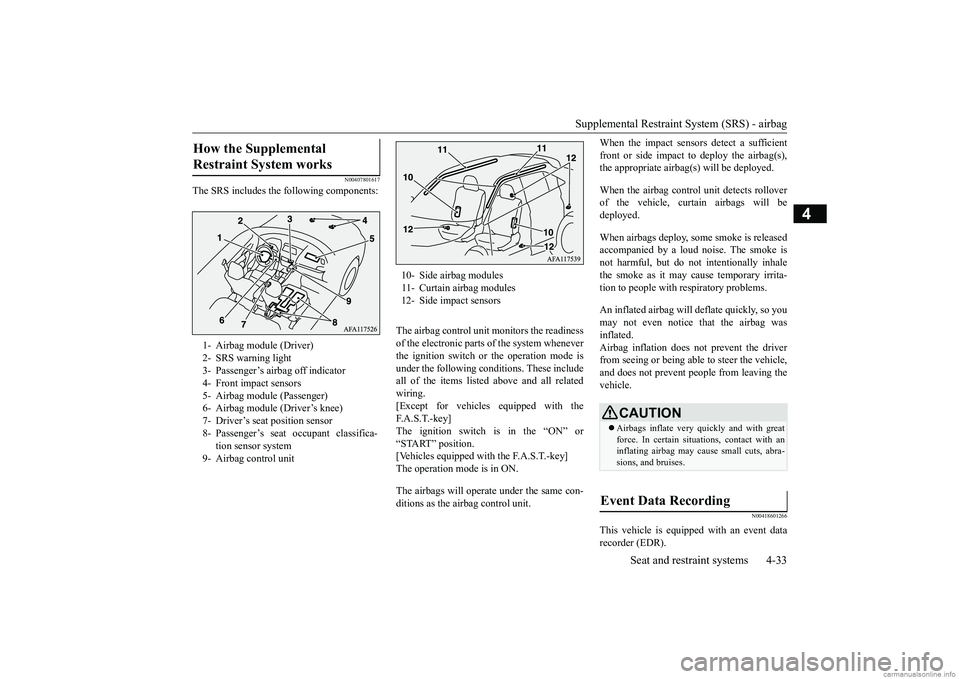
Supplemental Restraint System (SRS) - airbag
Seat and restraint systems 4-33
4
N00407801617
The SRS includes the following components:
The airbag control unit monitors the readiness of the electronic parts of the system whenever the ignition switch or the operation mode isunder the following conditions. These includeall of the items listed above and all related wiring. [Except for vehicles equipped with theF. A . S . T. - k e y ] The ignition switch is in the “ON” or “START” position.[Vehicles equipped with the F.A.S.T.-key] The operation mode is in ON. The airbags will operate under the same con- ditions as the airbag control unit.
When the impact sensors detect a sufficient front or side impact to deploy the airbag(s), the appropriate airbag(s) will be deployed. When the airbag control unit detects rollover of the vehicle, curtain airbags will bedeployed. When airbags deploy, some smoke is released accompanied by a loud noise. The smoke is not harmful, but do not intentionally inhalethe smoke as it may cause temporary irrita-tion to people with respiratory problems. An inflated airbag will deflate quickly, so you may not even notice that the airbag was inflated.Airbag inflation does not prevent the driver from seeing or being able to steer the vehicle, and does not prevent people from leaving thevehicle.
N00418601266
This vehicle is equipped with an event datarecorder (EDR).
How the Supplemental Restraint System works 1- Airbag module (Driver) 2- SRS warning light 3- Passenger’s airbag off indicator 4- Front impact sensors5- Airbag module (Passenger)6- Airbag module (Driver’s knee) 7- Driver’s seat position sensor 8- Passenger’s seat occupant classifica-
tion sensor system
9- Airbag control unit
10- Side airbag modules 11- Curtain airbag modules 12- Side impact sensors
CAUTION Airbags inflate very quickly and with great force. In certain situations, contact with an inflating airbag may cause small cuts, abra- sions, and bruises.
Event Data Recording
BK0252700US.bo
ok 33 ページ 2017年10月4日 水曜日 午後4時54分
Page 68 of 417
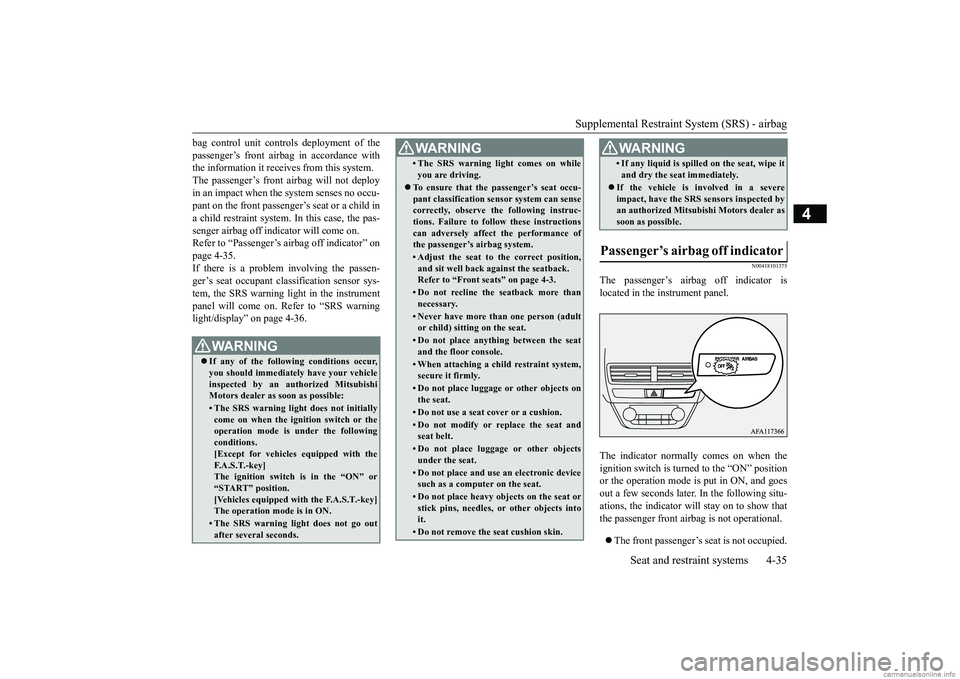
Supplemental Restraint System (SRS) - airbag
Seat and restraint systems 4-35
4
bag control unit controls deployment of the passenger’s front airbag in accordance with the information it receives from this system. The passenger’s front airbag will not deployin an impact when the
system senses no occu-
pant on the front passenger’s seat or a child in a child restraint system. In this case, the pas-senger airbag off indicator will come on. Refer to “Passenger’s airbag off indicator” on page 4-35.If there is a problem involving the passen-ger’s seat occupant classification sensor sys- tem, the SRS warning light in the instrument panel will come on. Refer to “SRS warninglight/display” on page 4-36.
N00418101375
The passenger’s airbag off indicator islocated in the instrument panel. The indicator normally comes on when the ignition switch is turned to the “ON” position or the operation mode is put in ON, and goes out a few seconds later. In the following situ-ations, the indicator will stay on to show that the passenger front airbag is not operational. The front passenger’s seat is not occupied.
WA R N I N GIf any of the following conditions occur, you should immediately have your vehicle inspected by an authorized Mitsubishi Motors dealer as soon as possible:• The SRS warning light does not initiallycome on when the ignition switch or theoperation mode is under the following conditions. [Except for vehicles equipped with the F. A . S . T. - k e y ] The ignition switch is in the “ON” or“START” position. [Vehicles equipped with the F.A.S.T.-key] The operation mode is in ON.• The SRS warning light does not go outafter several seconds.
• The SRS warning light comes on while you are driving.
To ensure that the passenger’s seat occu- pant classification sensor system can sensecorrectly, observe the following instruc- tions. Failure to follow these instructions can adversely affect the performance ofthe passenger’s airbag system.• Adjust the seat to the correct position,and sit well back against the seatback. Refer to “Front seats” on page 4-3.• Do not recline the seatback more thannecessary.• Never have more than one person (adultor child) sitting on the seat.• Do not place anything between the seatand the floor console.• When attaching a child restraint system,secure it firmly.• Do not place luggage or other objects onthe seat.• Do not use a seat cover or a cushion.• Do not modify or replace the seat and seat belt.• Do not place luggage or other objectsunder the seat.• Do not place and use an electronic device such as a computer on the seat.• Do not place heavy objects on the seat orstick pins, needles, or other objects into it.• Do not remove the seat cushion skin.WA R N I N G
• If any liquid is spilled on the seat, wipe it and dry the seat immediately.
If the vehicle is involved in a severe impact, have the SRS sensors inspected byan authorized Mitsubishi Motors dealer as soon as possible.
Passenger’s airbag off indicator
WA R N I N G
BK0252700US.bo
ok 35 ページ 2017年10月4日 水曜日 午後4時54分
Page 73 of 417
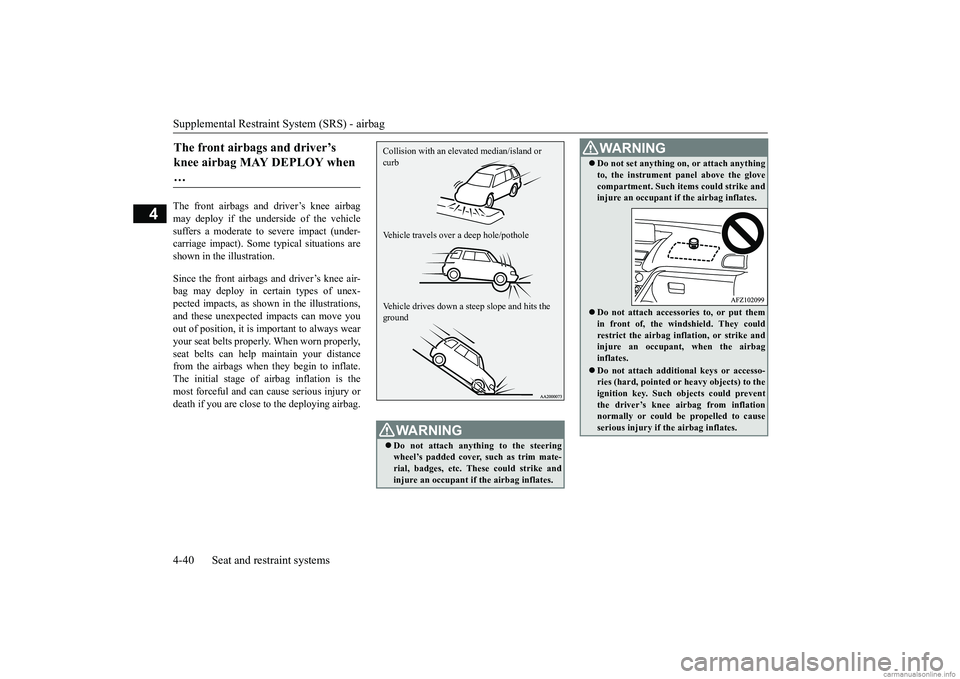
Supplemental Restraint System (SRS) - airbag 4-40 Seat and restraint systems
4
The front airbags and driver’s knee airbag may deploy if the underside of the vehicle suffers a moderate to severe impact (under- carriage impact). Some typical situations areshown in the illustration. Since the front airbags and driver’s knee air- bag may deploy in certain types of unex- pected impacts, as shown in the illustrations, and these unexpected impacts can move youout of position, it is important to always wear your seat belts properly. When worn properly, seat belts can help maintain your distancefrom the airbags when they begin to inflate. The initial stage of airbag inflation is the most forceful and can cause serious injury ordeath if you are close to the deploying airbag.The front airbags and driver’s knee airbag MAY DEPLOY when …
WA R N I N G Do not attach anything to the steering wheel’s padded cover, such as trim mate-rial, badges, etc. These could strike and injure an occupant if the airbag inflates.Collision with an elevated median/island or curb Vehicle travels over a deep hole/pothole Vehicle drives down a steep slope and hits the ground
Do not set anything on, or attach anything to, the instrument panel above the glove compartment. Such items could strike and injure an occupant if the airbag inflates. Do not attach accessories to, or put them in front of, the windshield. They could restrict the airbag inflation, or strike and injure an occupant, when the airbaginflates. Do not attach additional keys or accesso- ries (hard, pointed or heavy objects) to the ignition key. Such objects could prevent the driver’s knee airbag from inflationnormally or could be propelled to cause serious injury if the airbag inflates.WA R N I N G
BK0252700US.bo
ok 40 ページ 2017年10月4日 水曜日 午後4時54分
Page 80 of 417
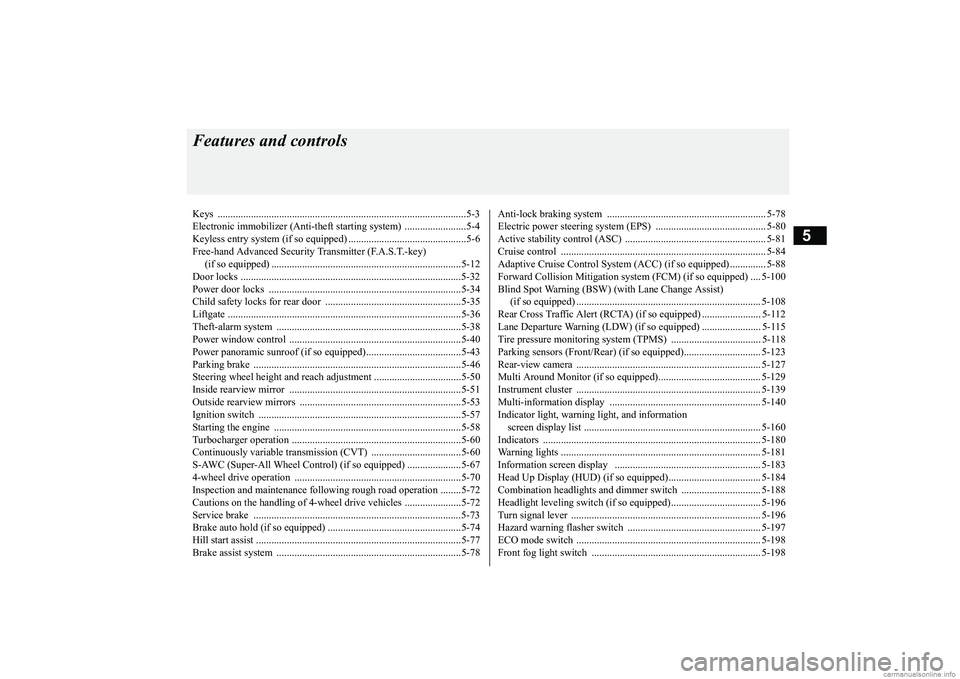
5
Features and controlsKeys ..........................................
.......................................................5-3
Electronic immobilizer (Anti-thef
t starting system) ........................5-4
Keyless entry system (if so equipped) ..............................................5-6 Free-hand Advanced Security Transmitter (F.A.S.T.-key) (if so equipped) .
.................................................
........................5-12
Door locks .......................
...............................................................5-32
Power door locks ............
...............................................................5-34
Child safety locks for r
ear door .....................................................5-35
Liftgate ......................................
.....................................................5-36
Theft-alarm system
................................................
........................5-38
Power window control
...........................................
........................5-40
Power panoramic sunroof (if
so equipped).....................................5-43
Parking brake ..................
...............................................................5-46
Steering wheel height and reach adjustment ..................................5-50 Inside rearview mirro
r ...........................................
........................5-51
Outside rearview mirr
ors ...............................................................5-53
Ignition switch ......
.................................................
........................5-57
Starting the engine
.................................................
........................5-58
Turbocharger operation
..........................................
........................5-60
Continuously variable trans
mission (CVT) ...................................5-60
S-AWC (Super-All Wheel Control) (if so equipped) .....................5-67 4-wheel drive operation
.........................................
........................5-70
Inspection and maintenance following rough road operation ........5-72Cautions on the handling of 4-wheel drive vehicles ......................5-72 Service brake ..................
...............................................................5-73
Brake auto hold (if so
equipped) ....................................................5-74
Hill start assist .......
.................................................
........................5-77
Brake assist system
................................................
........................5-78
Anti-lock braking syst
em .....................................
......................... 5-78
Electric power steering syst
em (EPS) ........................................... 5-80
Active stability control
(ASC) ....................
................................... 5-81
Cruise control ................
.................................................
............... 5-84
Adaptive Cruise Control System (ACC) (if so equipped) .............. 5-88 Forward Collision Mitigation system (FCM) (if so equipped) .... 5-100 Blind Spot Warning (BSW) (with Lane Change Assist) (if so equipped) ..........
.................................................
............. 5-108
Rear Cross Traffic Alert (RCTA) (if so equipped) ....................... 5-112 Lane Departure Warning (LDW) (if so equipped) ....................... 5-115Tire pressure monitoring system (TPMS) ................................... 5-118 Parking sensors (Front/Rear)
(if so equipped).............................. 5-123
Rear-view camera ..........
.................................................
............. 5-127
Multi Around Monitor (if so
equipped)........................................ 5-129
Instrument cluster
.................................................
....................... 5-139
Multi-information disp
lay ....................................
....................... 5-140
Indicator light, warning light, and information screen display list
..............................................
....................... 5-160
Indicators .................................
.................................................... 5-180
Warning lights ................
.................................................
............. 5-181
Information screen disp
lay ........................
................................. 5-183
Head Up Display (HUD) (if
so equipped).................................... 5-184
Combination headlights and dimmer switch ............................... 5-188Headlight leveling switch (if
so equipped)................................... 5-196
Turn signal lever ..
.................................................
....................... 5-196
Hazard warning flasher
switch .................................................... 5-197
ECO mode switch ..........
.................................................
............. 5-198
Front fog light switch
...........................................
....................... 5-198
BK0252700US.bo
ok 1 ページ 2017年10月4日 水曜日 午後4時54分